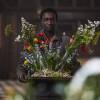Sometimes the hardest part about loving a television show is coming to terms with the fact that the characters aren’t real; that you’ll never be able to tag along for the adventures of your favorite rogue, or that you’ll never witness another beautiful scene between your favorite romantic leads. This is doubly frustrating (and confusing!) when the characters you so adore are accompanied by real, historical people about whom you can learn more. And so is the story for Lili Franchet, the brave lead of PBS’ Résistance, now available on Passport.
Another great selection from Walter’s Choice, Résistance follows the Groupe du Musée de L’Homme, one of the leading movements of the French Resistance, and is filled with powerful, poignant moments and enchanting performances. The star of the series is Pauline Burlet as Lili Franchet, a young woman who joins the group at its inception, and it’s through her daring acts and continued bravery that viewers learn just how courageous the Groupe du musée de l’Homme was.
So, we here at WGBH Drama Club wanted to know: was Lili Franchet a real historical figure? And the answer is: well... sort of. While the majority of characters in Résistance are based on real-life members of the Groupe, Lili is, in fact, fictionalized.

We learned that Lili is actually an amalgamation of several people, created to escort us, the viewers, through the many facets of the French resistance. Here are four historical women from the Groupe from whom Lili's story seems to have borrowed:
Marie-Josette Massip
A Resistance fighter, Massip joined the Groupe at the age of 18. Like Lili, Marie-Josette was the daughter of a man who fought and was wounded in World War I: Ernest Massip, a captain. And, also like Lili’s father, Ernest Massip was a Resistance fighter who was later arrested by the Gestapo. But while Lili was the only child of a widower, Marie-Josette had an older sister, Thérése, and mother, Suzanne — both of whom also served in the Resistance.
Renée Lévy
Unlike Lili, Lévy was Jewish. As the granddaughter of Alfred Lévy, Chief Rabbi of France from 1907 – 1919, Lévy could not officially work in France after the occupation. However, much like Lili, Lévy started her work in the Resistance as a newspaper and leaflet distributor. When the Groupe was disbanded, she moved on to work with a radio transmission service (also like Lili) that collected military intelligence and broadcast it to the Allies. Unfortunately, Lévy did not survive the war as Lili did. She was put to death on August 31, 1943.
Éveline Lot-Falck
Lot-Falck was the sister-in-law of Boris Vilde, one of the founders of the Groupe du Musée de L’homme. Like our heroine, Lot-Falk had a keen love for learning and an interest in journalism, which led her to begin her work at Musée as a volunteer as well as the the secret typist of the Resistánce newspaper. But Lot-Falck was quick to go beyond her secretarial duties, gaining a certification in ethnology, and even learning Russian and Mongolian as part of her work. These skills led to a storied career after the war studying the indigenous peoples of Central and Upper Asia as well as Siberia.
Yvonne Oddon
Unlike the three other women on this list, Yvonne Oddon was one of the many Resistance fighters who actually made an appearance in the show, as portrayed by Philippine Pierre-Brossolette. One of the founders of the Groupe du Musee de L’homme, she was a librarian at the museum, much like Lili. And, like Lili’s work in the middle of the series, Oddon helped prisoners of the Nazi’s escape, providing them with food and shelter along the way. As we saw in the series, she was imprisoned in Ravensbrück, but, after the war, she went on to work for UNESCO.
Take your own trip through the history of the French Resistance — and, if you’ve yet to watch Résistance, check it out on Passport today!









